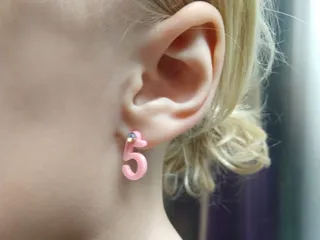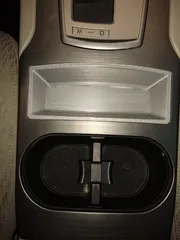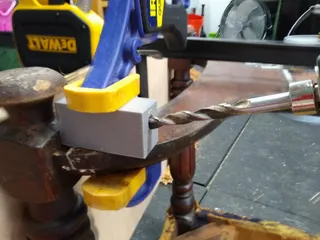Metal cast challenge coin and mold
Description
PDFThis is a 45 mm diameter 5mm thick challenge coin and mold to make a reusable silicone mold that can be used to cast the coins in metal. I call this part the MoldMold. I've made 15 coins out of the first mold so far and the mold has held up 100% so far.
Background
I've been interested in Challenge Coins since this episode of podcast99% Invisible. Last year I had my own minted through an online service. I think the material is zinc. I had to order 300 of them to get the per coin price down and avoid die fees and the price was still about $3.50 per coin. Then I came across this casting project and it inspired me to print / cast my own. Total cost is about $4 in PLA and $6 in molding silicone plus $1.30 in metal per coin ... and 50 hours designing and printing and about .5 hrs per finished coin times $0 per hour for my time. I have since made a second coin for my nephews and only had to print new coins (with fewer iterations) and reused the MoldMolds and poured new molds into them.
I was really impressed with the amount of detail I was able to get out of my printer and how well the detail transferred to the final coin. The finished product you see is straight from the mold with no sanding or buffing. The edges of the coin have a slightly uneven look, especially where the two sides of the silicone line up due to compression of the mold. I like this bit of wabi-sabi that separates my hand made coins from chuck-e-cheese tokens.
Print instructions
Category: Coins & Badges Print Settings
Printer: MP Mini Delta
Rafts: Yes
Supports: Yes
Resolution: .05
Infill: 10%
Notes:
Design your coin at 45 mm and 3 - 6 mm thick and you should be able to use this MoldMold as is.
I tried printing the coin in various ways and had best results when I printed it standing on it's edge with a large brim and support up the curved sides. Max resolution on my printer is .05 mm. I had to go very slow and had a bunch of failed prints where the coin would fall over half way through. Afterwards I had to sand away where the brim was attached. Print time ~ 2.25 hrs per coin.
The MoldMold was straight forward to print, once I went through 4 iterations to get everything to fit together. I first modeled the mold in F360 and printed a few iterations. Once those fit together I designed the MoldMold around it and printed a few more iterations. Printed at .2 mm layer height with a brim to prevent some curling up at the edges - this part filled up my tiny 110 mm diameter bed.
Print 2 coins and 2 moldmolds so that you can pour molds for both sides at once. This way you only have to wait overnight once and there will be less excess silicone wasted.
Post-Printing
Making molds and casting
Molding
I pretty much followed the tutorial for the flat pack arm.
I used Mold Star 30 silicone molding rubber. There are two variants of the silicone molding rubber: Mold Star 15 (in the above project) and Mold Star 30 (what I went with). Same price. The 30 is slightly firmer which makes it a little harder to remove from the MoldMold but also theoretically will hold it's shape better. I was lucky enough to work near a Mold Star distributer and they had samples in their show room to feel. I'm sure either one would work the same. The other 5,000 mold star compounds either don't hold to high enough of a temperature, expand/shrink too much, or require some sort of vacuum treatment to get air bubbles out of them.
The molds are designed with locating pins to only fit together in one way. Snap the coins into the molds, making sure to get the coin orientation you desire. There's a right way, it's just that no one can agree on it.
Mix the rubber according to the instructions. I don't know how important it is, but I followed the advice to pour from as tall a distance as I could accurately manage (about 12-18") in a thin stream. This will supposedly elongate and pop any air bubbles as they stir. I slowly poured into the lowest part of the mold and let the level rise up (fight the urge to dribble it all over your coin, increasing the risk of air bubbles).
HINT To know how much rubber to pour I filled one MoldMold with water and poured it into a cup and marked the level (plus another half ounce or so to be safe). This is the amount of each part of the silicone mix to use.
I wish I had also followed gianteye's advice to level the MoldMolds with pieces of paper. They were off by a tiny bit, but it doesn't really matter since that's the back of the mold anyways.
Walk away. Don't poke it or try to test it. Just leave it alone for 6 hours.
I used a dull scraper and fingers to release the mold edges from the MoldMold. Pulling it out feels like it's going to rip but it came out fine. I used a pen-knife to clean up a little bit of thin silicone on the edges, especially where the vent and sprue holes meet the coin.
Because of the expense and small amount of the rubber and time per trial I was real worried about the mold process. I've made two coin molds and they have both worked on the first try, so it's more forgiving than I thought it'd be.
Casting
Supplies:
- Sacrificial pot from thrift shop (you are never going to want to eat out of this afterwards)
- Sacrificial muffin pan
- Small cookie tray (optional, can also be reused for food)
- Low melt metal
Baby powder
The mold compound is rated to 450F (not a hard limit, you can probably go over this). The cheapest lead-free alloy I can find is this Roto281-338F tin-bismuth. Note that gianteye used the $1-more-per-pound Roto281F (the name is the melting point). I bought a pound of each and the resultant coins seem identical as far as I can tell. A little bit of metal gets lost sticking to the sides of things every time you heat it up and transfer it so I'm getting about 12 coins per pound.The metal comes in 1 lb ingots. To save having to heat all that material up repeatedly I melted it down and poured it into 3 compartments of my mini-muffin tray. I also modded my pot by bending a pouring kink into with some big pliers to make my pouring a little more accurate. Smack the muffin tin on the ground to knock out the metal muffins. They can stick the first time and require some love taps from a hammer.
The mold needs to be somewhat warm or else the metal gets a rough and pitted surface from cooling before completely forming. You can use a heat gun to warm it up (quick) or what I did was put it on a cookie tray in a cold oven and set it to keep warm (180F). The oven took 10-15 minutes to come to temperature and then the molds were warm all the way through, but you could still handle them if you were quick.
While the molds are in the oven get a muffin of metal in the pot and turn it on medium-high. Turn on the heat right as you are going to get the molds out of the oven, it only takes 2-3 minutes to melt. I had a burner on my outdoor grill. If indoors make sure you have a vent fan on, it smells like burnt metal and I don't know what the toxicity of inhaled bismuth and tin is, but it's greater than the toxicity of bismuth-free and tin-free air.
When the molds come out give a very small dusting of baby powder, spread it around with your fingers if ye be brave enough, clap the molds together to make sure there is only a fine layer of powder in there. Put the mold together and use a clamp with some boards to distribute the pressure. I initially used a clamp and some little rectangles of a thin plywood. I later added some screws and wing nuts to make the apparatus less bulky. Gentle pressure is all you need, just enough to make sure the mold halves seal all the way around. You don't want to deform the mold and make a squish-coin. I flick the wing nuts until they hit the board and then another half turn.
Once the metal is melted pour it into the upright-and-clamped mold. Don't dump it. Pour smoothly, keeping a not-quite-full pool of metal at the top. In 1-2 seconds when that sprue starts to fill up you can stop. If you can see metal in the two angled vent holes then you can definitely stop. This may be superstition, but I will gently flick the wood supports or knock my knuckles on the table to cause some vibrations to hopefully make sure the metal flows into all the details on the mold. Wearing a glove or oven mitt is a good idea, and I often remember to.
Immediately pour the rest of the metal back into the muffin tin for compact tear down when you are done. Let the coin sit, parts of it will still be soft for at least 5 minutes and it will be at least 20 minutes before it is merely warm.
The mold comes apart easily and the coin will come out with the sprue metal still attached and little nubs from the vent hole. I've been able to snap this off with just my fingers. There is a slight mark at the top that could be sanded but I've never bothered and no one's ever noticed. I do no further work to the coins and hand them out as-is.
I've been able to skip the oven warming for subsequent coins in the same session. Wait one beer (~10 minutes) after pouring and demold the coin onto a paper towel or something soft then immediately put the still-warm mold back in the bracket for an immediate re-cast. I've done a 6 coin session like this and the mold was doing fine. I needed a nap afterwards.
The snapped off sprue, vent tubes, and reject coins can all be thrown back in the pot for another go around. The only waste comes from crusty stuff sticking to the pot, so a smaller pot will have less wasted metal.
How I Designed This
I designed the parts in Fusion 360. For the coin I took reference images and attached them as backgrounds, drew splines over them, and then extruded the sections up and down. With my printer I found .2 mm increments in extruder heights were sufficient to make small features stand out distinctly. The main lip around the edge was 1 mm and the main feature of the animal faces was .8mm with smaller features being 1mm high. If I were doing it again I'd make the lip around the edge wider, it's currently 1 mm wide, since the edges of the coin didn't flow well at the top, possibly due to not enough pressure from the sprue.
The hardest parts of this project were getting the F360 circular pattern looking pretty. I had a rough idea what I wanted, but not the design skills to realize my vision. Also F360 can not do curved text so I had to spend a couple days learning InkScape (hardest part: installing on a Mac!) so that I could make curved text.
The MoldMold made heavy use of parameters so that I could try different tolerances and heights on the different features (alignment pins, vents, sprue, thicknesses of things). I read somewhere a .5" thickness minimum for the mold and my small build plate (110mm diameter) prevented me from adding any taller of a sprue. I think with a taller sprue I could have a little more pressure on the very top of the coin and get the edge to fill out a little better. I'd also like to add a little lip to make releasing the mold easier. I'll update when I get a bigger printer (on order) and can test that.
Tags
Model origin
The author marked this model as their own original creation. Imported from Thingiverse.




